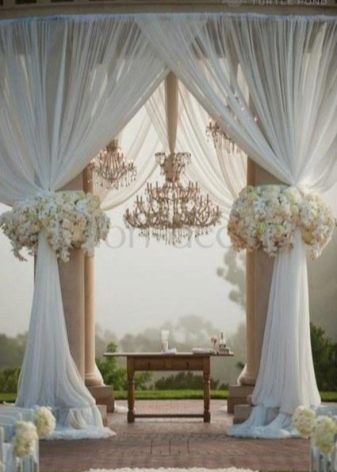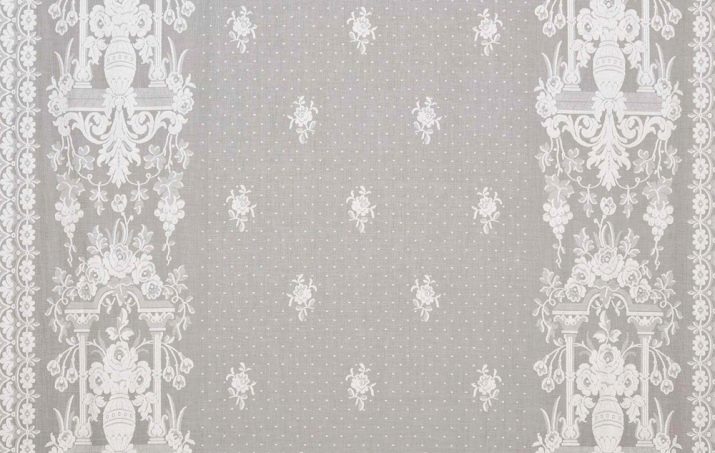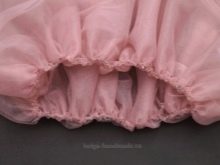All about transparent fabrics

Transparent fabrics are indispensable for many products - for outfits, stage designs, window decorations and more. They are gentle and delicate, and that is why not everyone likes to work with them, considering that it is very troublesome. In fact, there is nothing to be afraid of, and such fabrics have interesting possibilities and variations in use.

general description
The main properties of transparent fabrics are they are light, airy, soaring. They are perfectly ventilated, they are weightless and thin, but they require careful treatment. Without them, it is difficult to imagine an evening or wedding dress, decoration and decor of some other fabrics, stage costume. They are used both in smart home textiles and in interior decor. Summer clothes are also often made with the help of transparent fabrics.

There are natural ones, and there are synthetic ones, expensive and not so, plain and printed. The fabric can have delicate embroidery, or by itself it will be honeycomb, almost airy. There is a dense transparent fabric, and there is a soft one, there is a lace fabric, and there is a strict one, without sophistication. And one such insert made of transparent material is capable of making a simple, ingenuous thing an original outfit.


Views
The following are the characteristics of the most popular transparent fabrics.
Veil
Smooth, translucent and free flowing fabric. Can be dyed and finely patterned... Usually it is a cotton cloth, sometimes silk or woolen. Plain weave is more often inherent in such fabric.
The veil is washed especially carefully, in warm water, by hand; the material is extremely difficult to withstand mechanical stress. But there are fewer problems with ironing, usually the fabric does not conflict with temperature exposure.

Where Veil Is Used:
-
in wedding decor, from which not only a bridal veil can be made, but also decorations for a festive interior, for a car and much more;
-
for window curtain, curtains, lambrequins and other interior decor;
-
for decor - flowers, feathers, various decorations;
-
to create dresses and blouses, but more often in combination with an opaque lining.


Veils are bleached, printed and plain dyed. But any kind of veil creates the impression of an airy matter, it flows well and allows air to pass through perfectly. The fabric is a little capricious in sewing, and if stored incorrectly, it wrinkles. It is best to soak the veil in cool water and liquid detergent for several hours before washing it.

Chiffon
Chiffon is a translucent cotton or silk fabric. Other threads can be added there as well. The fabric is not entirely smooth, it is characterized by some roughness and dullness. Dresses for celebrations are usually made of chiffon. The fabric is very breathable, a person in such clothes will not feel like in a greenhouse. Particularly popular are chiffon shawls and pareos, which are out of fashion and are always in demand.

Chiffon fabric options:
-
chiffon-jacquard - low crease canvas, not quite transparent, smooth;
-
chiffon-crepe - bleached and plain-dyed fabric, strong and dense, made of two-strength silk threads;
-
chiffon satin - smooth, shiny, transparent matter;
-
pearl chiffon - it has a beautiful pearl shade;
-
shangjan - Thin and lightweight reflective fabric;
-
chameleon - this canvas shimmers in the light and includes several shades at once, it looks very impressive;
-
nylon - durable, even without processing the edges of the fabric will not fray.



They also sew blouses and summer dresses, dresses and tunics, sarafans, vests, skirts, capes, hats from chiffon.
The fabric will not tolerate chlorine, it must be washed exclusively with liquid products. Better if it is hand wash. Chiffon is not dried in the bright sun, otherwise the matter will "creep away". The fabric is ironed on the "silk" mode.

Batiste
Modern cambric is usually a blended fiber, when polyester or viscose is added to a natural base. In many ways, this material can be considered the most profitable of transparent fabrics - it is lightweight, weightless, maximally comfortable to wear, ventilated, and resistant to deformation. And dirt on cambric is easily washed off.
This is how cambric is.
-
Bleached... It is a cotton fabric, often laced or delicately hand-embroidered. A great option for wedding wear, as well as underwear, clothes for babies, bed decor.

- Plain dyed. This fabric is very bright, saturated colors. Colored tablecloths, napkins, bed linen and curtains are made from it.

- Mercerized. Wear-resistant fabric, durable and very comfortable for curtains and interior decoration.

- Printed. Such material has beautiful embroidery and patterns. For summer outfits, a very popular option.

Initially, cambric was only linen or cotton, but now synthetics are added to the fabric to increase its wear and performance. Does not retain moisture, it is comfortable to wear. It lies in beautiful folds.
Chintz
It is a lightweight cotton fabric obtained by finishing calico. It has a plain plain weave. Soft, pliable fabric, pleasant to the touch... And many people choose it because it is a natural material. The main purpose of the chintz is a blouse and linen version, as well as a dress one. Differs in moderate electrification, average level of air permeability, average rate of moisture absorption.

Chintz is used to sew men's and women's shirts, curtains and curtains, underwear and home clothes, summer dresses and sundresses, blouses and skirts. It makes comfortable nightgowns and pajamas, dressing gowns. The main advantages of chintz are environmental friendliness, hypoallergenicity, regulation of heat exchange, safety, softness. Of the minuses, it is worth noting that the fabric, alas, wrinkles a lot, deteriorates when washed in hot water.It is possible that pellets will quickly form on it.

Georgette
And this beautiful canvas is made of twisted yarn using the plain weave method.... It is a light and translucent fabric, quite tough and elastic. Its big plus is that it retains its shape perfectly. But after washing, however, it can sit down, you need to be careful. And also the disadvantages of the fabric can be attributed to its slightly grainy structure, and therefore for people with sensitive skin, things made of georgette are not always convenient.
Today, the composition of this fabric can be anything, synthetics and polymers are added to it, as well as silk, cotton, viscose. Georgette can be monochromatic (one color), printed (that is, with a pattern or print), degradation (soft change in shade from dark to light), shade (smooth tonal play), crash (special dented fabric). Another big plus of georgette is that it is an all-season fabric.

Fatin
This is a mesh stretch fabric made from nylon, polyester or nylon.... Most often she can be seen in very fluffy skirts or petticoats. I must say that the tulle threads are quite thick, but the cells between them are small. The material forms shuttlecocks, folds and ruffles very well, drapes perfectly.
The fabric is appreciated for its elasticity, layering and good stain resistance. On the one hand, layering is good, but because of it, it does not allow air to pass through well. Soft tulle is more often used for sewing fluffy skirts and dresses. Petticoats are usually made of medium tulle, as well as artificial floristry and those very white (and black too) ballet tutus.
Hard tulle is suitable for creating souvenirs, decorations for interiors and cars.

Fabric Tips
These canvases are easy to drape, forming graceful folds. It is convenient to wear them, because there will be no effects hindering movement. And to make something modest more elegant, you can even visually turn a simple thing into an expensive one with the help of transparent fabric.
Let's see how to work properly with such a delicate material.
-
Fabric may slip and slide off the table during cutting... To avoid this, you should put a piece of felt or, for example, flannel on the fabric.
-
The needles are used long and thin... If you have to work on a typewriter, a needle no thicker than "seventy" is taken.
-
To keep the line straight the fabric is sewn with thin paper backing.
-
Slices must be processed on an overlock. If it doesn’t work, they make a “Moscow” seam - double with a hem and edge sealing. You can process a seam with a bias tape or piping.
-
Working with a thin canvas, instead of darts (they will look rough), apply light folds or draperies.
-
Ironing must be done carefully so that the iron is exposed on a sparing mode.
-
Do not sew across the gold pins on sheer fabric. Otherwise, puffs and uneven stitches will form.



In a word, a special approach is required, but everyone can master it.
Care rules
All information is usually indicated on a tag, label. And this should be read first.
The standard care requirements are as follows.
- You need to wash transparent fabric in cool water, you can use your hands... If, nevertheless, a machine wash is chosen, choose a delicate program or one that meets the requirements of the fabric on the label. Only liquid detergent is used, chlorine-containing compounds are excluded.
- If the fabric is very thin, wring it out as gently as possible.... The machine excludes the spin mode altogether - only by hand.
- It is necessary to dry transparent fabrics by hanging the item on a hanger. You can do this simply on a horizontal surface. Drying in the machine is not allowed, under the sun - also not. The transparent cloth is also not dried on the battery.
- If not necessary, it is better not to iron a transparent cloth at all.... But if it is very wrinkled, ironing is possible only at the minimum temperature. The silk setting on the iron should work.
You can sew an elegant wardrobe item or interior decor from a transparent material with your own hands. And often it is all very cheap, but it looks elegant and original.










